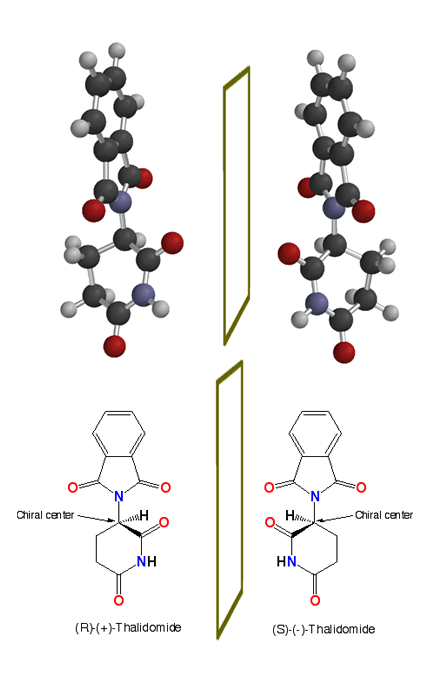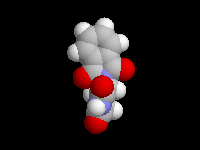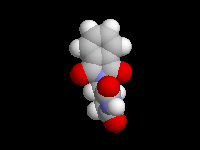


Thalidomide is a hypnotic and anti-nausea drug that was given to many patients, including pregnant women in Canada and Europe in the late 1950's to early 1960's.
There is one chiral center in thalidomide. In the rotating animated views of the two thalidomide enantiomers, find the chiral centers and notice how subtle the differences are in structyure between the enantiomers.
The drug was given as a racemic mixture. Unknown at the time, the (S)-(-) enantiomer (but apparently not the (R)-(+) enantiomer, although this is still controversial) is transformed in patients to two compounds that are embryotoxic and teratogenic. Regardless of whether one or both enantiomers are involved, taking thalidomide by pregnant women caused severe birth defects including abnormal (missing) limbs, as well as ear, eye, heart and gastrointestinal problems in 10,000 babies born. Interestingly, the two thalidomide enantiomers undergo interconversion in animals, so just giving the (R)-(+) isomer would not work even if the (S)-(-) enantiomer is the only one to cause problem! Very recently scientists have uncovered clues about how thalidomide caused birth defects although much remains to be learned.
Thalidomide was never released in the US because US officials were concerned about some preliminary data in animals showing the birth defect problems. Click here to see some examples of typical thalidomide birth defects.
Thalidomide was a tragic but important incident that has shaped government policy torward new drugs ever since. Two important lessons were learned:
1) Chiral drugs need to be evaluated as pure enantiomers because the different enantiomers can have completely different effects. It is generally true that only one enantiomer is active, and every effort now is made to use only that enantiomer in manufactured drugs.
2) New drugs need to be tested thoroughly, including their metabolized products (!). That is why we have such a powerful FDA and why it costs drug companies as much as $800 million or more to test EACH new drugs. We pay for this cost with high drug prices, but the alternative, namely serious health problems and side effects, make this seem like a bargain!
Interestingly, thalidomide has more recently been found to have good immunomodulatory and antiangiogenic activities and is being reinvestigated as a new drug. Of couse, pregnant women would never use it!!!!
Click here for some links to review articles about thalidomide. These are just the abstracts, you can read the entire articles through the electronic journals section of the UT libraries webpage.